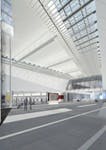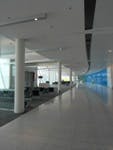For the Canberra terminal, Guida Moseley Brown Architects (GMB) was hired by the Canberra Airport Group. Stage 1 of the project was completed 12 months ago and Stage 2 is currently under construction. “In Stage 1, Klik Systems demonstrated a capability and quality which gave us confidence to work with them to design a fully customized housing for the Stage 2 Atrium,” said Rob McLachlan of GMB.
Lighting Design Partnership designed the lighting, and Rudds Consulting Engineers handled the electrical and mechanical design services, back-up power and tri-generation. On-site tri-generation allows for aircraft 400-Hz power systems to be incorporated into the building, thereby minimizing the use of aviation fuel for parked plane power.
The lighting is designed to the highlight the building’s surfaces and geometry, including a curved airside façade. McLachlan used Klik’s suspended 110 custom beam luminaires throughout the airport. Curved beams in the gate lounge mirror the sloping façade. The series of beam pendants help visitors to locate the central atrium, lounges, and baggage belts. The beams provide illumination of the floor and ceiling surfaces simultaneously.
“A key lighting feature introduced in the terminal is the concept of 'active light,' at either end of the journey through the terminal, the aero bridges and the baggage belt zone,” said Dhruvajyoti Ghose, managing director of Lighting Design Partnership in New South Wales. When inactive, the belt is illuminated using blue light, which turns to white when the belt is in use. The Klik beam was modified to incorporate two light sources, which are automatically switched on belt activation.
Intelligent DALI control systems minimize lighting power usage using sensors, time schedules and automatic daylight dimming. “Stage 2 of the Terminal features a vastly increased range of LED products included within Klik beams and other fittings in order to minimize both on-going energy use and maintenance requirements,” said Olaf Theden, senior electrical engineer at Rudds.
On August 6, the city of Canberra, 300-km Southwest of Sydney, is set to become a focus of attention when the Canberra Deep Space Communication Complex is set to receive signals from NASA's Mars Science Laboratory rover Curiosity as it lands on Mars. The Canberra Airport, a 45-minute drive from the CDSCC, is preparing for an influx of scientists, astronomers and deep space enthusiasts, keen to observe the event at this site.







